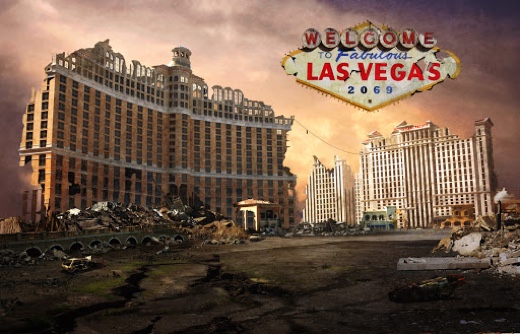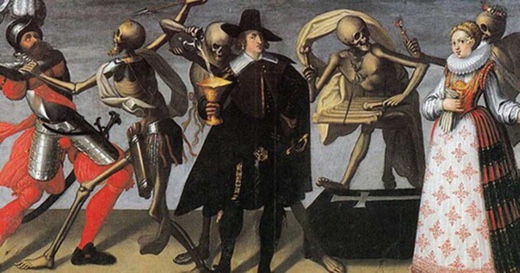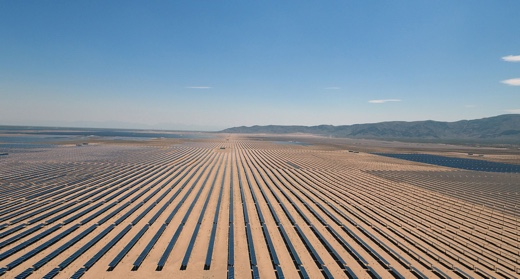SUBHEAD: Our national economy is too fragile, brittle, bankrupt, corrupt and hopelessly perverse.
By Charles Hugh Smith on 26 May 2020 for Of Two Minds -
(http://charleshughsmith.blogspot.com/2020/05/re-opening-economy-wont-fix-whats-broken.html)

Image above: Illustration of the ruins of Las Vegas with the Bellagio Casino in the left foreground and Caesar's Palace to the right for the story "Underneath Us" by Alex TIllson. From (http://alextillson.com/writing/underneath-us/).
Fragile economies cannot survive any impact with reality that disrupts the distortions that are keeping the illusion of "growth" from shattering.
While the stock market has soared, the real world falls apart. If your region needs a new bridge built, count on about 20 years to get all the "stakeholders" to agree and get the thing actually built.
Want to add a passenger stop on an existing railroad line? Count on 20 years to get it done.
The complexity thicket of every regulatory agency with the power to say "no" basically guarantees the project will never get approved, because every one of these bureaucracies justifies its existence by saying "no." Sorry, you need another study, another environmental review, and so on.
Need a new landfill? I hope you started the process 15 years ago, so you'll get approval in only five more years. Every agency with the power to say "no" will stretch out the approval, so they have guaranteed "work" for another decade or two.
Did your subway fares double? Was the excuse repairing a crumbling system? Did the work get done on budget and on time? You must be joking, right? All the fare increase did was cover the costs of skyrocketing salaries, pensions and administrative costs. Repairs to the tracks and cars-- that's extra.
Have you been thrown off your bicycle by the giant potholes in the city's "bike lanes"? The city reluctantly admits that these streets that haven't been maintained for decades--yes, decades.
These real-world examples are just four of thousands of manifestations of a broken system. Rather than make tough choices that drain power and wealth from vested interests, we simply borrow more money, in ever increasing amounts, to keep the entrenched interests and elites happy.
There are two "solutions" in the status quo: dump the debt on taxpayers or on powerless debt-serfs--for example, college students. (See chart below of the $1.6 trillion that's stripmining student debt-serfs.)
Who benefits from selling all the municipal bonds, bundled student loans, etc. to investors starving for a yield above 0.1%? Wall Street, of course.
The problem is that while debt has soared, productivity and earned income have stagnated. The statistical narrative has been ruthlessly gamed to hide the erosion of living standards, but even with the bogus "low inflation" of official statistics, wages for the bottom 95% have stagnated for decades.
Measures of productivity have also been gamed to mask the ugly reality that the vast majority of the U.S. economy is stagnating under the weight of interest payments on debt, mal-investments in speculative gambles, higher junk fees and taxes, crushing regulatory compliance, high costs imposed by monopolies and cartels and a well-cloaked decline in the quality of just about everything the bottom 95% uses or owns.
What little productivity gains have been made have been skimmed by the top 5%. Coupled with the Federal Reserve's single-minded goosing of the one signaling device it controls, the stock market, the top 0.1% in America own more wealth than the bottom 80%.
If productivity stagnates and winners take all, the wages of the bottom 95% cannot rise. Real wealth is only created by increases in the productivity of labor and capital; everything else is phantom wealth.
The only way stagnant incomes can support more debt is if interest rates decline. Presto, the Fed dropped interest rates to near-zero a decade ago.
Debt-serfs were able to refinance their crushing mortgages to save a few bucks, and so they can afford to 1) take on more debt and 2) pay higher taxes to fund the ballooning public debt.
Every one of these extremes has increased the systemic fragility of the American economy. This fragility is reflected in the impoverishment of the bottom 95%, the thin line between solvency and bankruptcy, the decay of public trust in institutions run for the benefit of entrenched interests, and the quickening erosion of America's social contract.
Re-opening a fragile, brittle, bankrupt, hopelessly perverse and corrupt "normal" won't fix what's broken.
.
By Charles Hugh Smith on 26 May 2020 for Of Two Minds -
(http://charleshughsmith.blogspot.com/2020/05/re-opening-economy-wont-fix-whats-broken.html)

Image above: Illustration of the ruins of Las Vegas with the Bellagio Casino in the left foreground and Caesar's Palace to the right for the story "Underneath Us" by Alex TIllson. From (http://alextillson.com/writing/underneath-us/).
The stock market is in a frenzy of euphoria at the re-opening of the economy. Too bad the re-opening won't fix what's broken. As I've been noting recently, the real problem is the systemic fragility of the U.S. economy, which has lurched from one new extreme to the next to maintain a thin, brittle veneer of normalcy.
Fragile economies cannot survive any impact with reality that disrupts the distortions that are keeping the illusion of "growth" from shattering.
For the past two decades, every collision with reality cracked the illusion, and the "fix" was to duct-tape the pieces together with new extremes of money-creation, debt, risk and speculative excess.
While the stock market has soared, the real world falls apart. If your region needs a new bridge built, count on about 20 years to get all the "stakeholders" to agree and get the thing actually built.
Count on the cost quintupling from $500 million to $2.5 billion. Count on corners being cut as costs skyrocket, so those cheap steel bolts from China that are already rusting before the bridge is even finished? Oops. Replacing them will add millions to the already bloated budget.
Want to add a passenger stop on an existing railroad line? Count on 20 years to get it done.
The complexity thicket of every regulatory agency with the power to say "no" basically guarantees the project will never get approved, because every one of these bureaucracies justifies its existence by saying "no." Sorry, you need another study, another environmental review, and so on.
Need a new landfill? I hope you started the process 15 years ago, so you'll get approval in only five more years. Every agency with the power to say "no" will stretch out the approval, so they have guaranteed "work" for another decade or two.
Did your subway fares double? Was the excuse repairing a crumbling system? Did the work get done on budget and on time? You must be joking, right? All the fare increase did was cover the costs of skyrocketing salaries, pensions and administrative costs. Repairs to the tracks and cars-- that's extra.
Let's float a $1 billion bond so nobody have to tighten their belts, and have riders pay for it indirectly, through higher taxes to pay the exorbitant costs of 20 years of interest on the bond.
Have you been thrown off your bicycle by the giant potholes in the city's "bike lanes"? The city reluctantly admits that these streets that haven't been maintained for decades--yes, decades.
The city once paid for street maintenance out of its general budget, but alas, that's been eaten up by skyrocketing salaries, pensions and administrative costs, so now we need to float $100 million bond to fund filling potholes.
If all goes according to plan (ha-ha), we should be able to re-pave the streets that have been crumbling for 20 years in... the next 20 years.
If all goes according to plan (ha-ha), we should be able to re-pave the streets that have been crumbling for 20 years in... the next 20 years.
These real-world examples are just four of thousands of manifestations of a broken system. Rather than make tough choices that drain power and wealth from vested interests, we simply borrow more money, in ever increasing amounts, to keep the entrenched interests and elites happy.
There are two "solutions" in the status quo: dump the debt on taxpayers or on powerless debt-serfs--for example, college students. (See chart below of the $1.6 trillion that's stripmining student debt-serfs.)
Who benefits from selling all the municipal bonds, bundled student loans, etc. to investors starving for a yield above 0.1%? Wall Street, of course.
The problem is that while debt has soared, productivity and earned income have stagnated. The statistical narrative has been ruthlessly gamed to hide the erosion of living standards, but even with the bogus "low inflation" of official statistics, wages for the bottom 95% have stagnated for decades.
Measures of productivity have also been gamed to mask the ugly reality that the vast majority of the U.S. economy is stagnating under the weight of interest payments on debt, mal-investments in speculative gambles, higher junk fees and taxes, crushing regulatory compliance, high costs imposed by monopolies and cartels and a well-cloaked decline in the quality of just about everything the bottom 95% uses or owns.
What little productivity gains have been made have been skimmed by the top 5%. Coupled with the Federal Reserve's single-minded goosing of the one signaling device it controls, the stock market, the top 0.1% in America own more wealth than the bottom 80%.
If productivity stagnates and winners take all, the wages of the bottom 95% cannot rise. Real wealth is only created by increases in the productivity of labor and capital; everything else is phantom wealth.
The only way stagnant incomes can support more debt is if interest rates decline. Presto, the Fed dropped interest rates to near-zero a decade ago.
Of course you and I can't actually borrow millions for 0.1%; that privilege is reserved for financiers and other financial parasites and predators.
Debt-serfs were able to refinance their crushing mortgages to save a few bucks, and so they can afford to 1) take on more debt and 2) pay higher taxes to fund the ballooning public debt.
Every one of these extremes has increased the systemic fragility of the American economy. This fragility is reflected in the impoverishment of the bottom 95%, the thin line between solvency and bankruptcy, the decay of public trust in institutions run for the benefit of entrenched interests, and the quickening erosion of America's social contract.
Re-opening a fragile, brittle, bankrupt, hopelessly perverse and corrupt "normal" won't fix what's broken.
.


